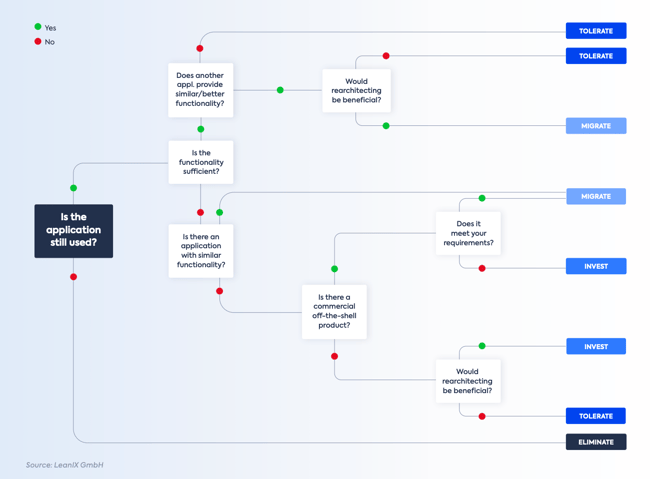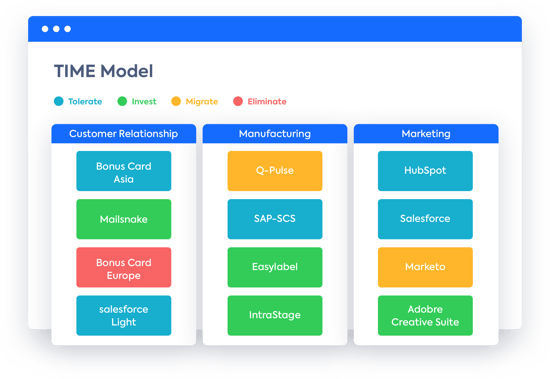[CONTINUED]
Implementing the TIME model
Implementing the Gartner® TIME framework involves a systematic approach that begins with a thorough assessment of the application portfolio.
Here are the steps to follow:
The first step is to create an inventory of all the applications in use within the organization. This includes not only the applications that are officially sanctioned but also those that are used informally by different teams.
Assess each application for its technical fit and functional fit. The technical fit relates to the quality of the application, its maintainability, and its compatibility with other systems. The functional fit refers to how well the application aligns with business needs and supports business capabilities and processes.
3. Categorize applications into TIME quadrants
Based on the assessment in the previous step, categorize each application into one of the four TIME quadrants: Tolerate, Invest, Migrate, or Eliminate. This categorization provides you with a clear roadmap for managing each application.
 Application rationalization decision tree. Source: Guide to Application Rationalization
Application rationalization decision tree. Source: Guide to Application Rationalization
Besides the helpful decision tree above, try answering these questions for each application. Use Tolerate quadrant as the starting point:
- Does the application meet or surpass technical standards? If yes, proceed to the next question. If no, consider other quadrants.
- Is the application easy to maintain and easy to use without advanced training? If yes, proceed to the next question. If no, consider other quadrants.
- Does the application align with business needs and support business capabilities and processes? If no, the application falls under the Tolerate quadrant. If yes, consider the Invest quadrant.
For each quadrant, a specific action plan is developed to reach desired target portfolio state:
- Tolerate: applications are maintained in their current state
- Invest: applications are targeted for enhancement or expansion
- Migrate: applications are planned for replacement
- Eliminate: applications are scheduled for decommissioning
5. Execute and monitor
The action plans are then executed with careful monitoring to ensure the desired outcomes are achieved. This may involve project management, change management, and risk management activities.
6. Review and update
The TIME model is not a one-time exercise but a continuous process. The application portfolio should be reviewed regularly, and the TIME categorizations updated as necessary to reflect changes in the applications or in the business needs and objectives.
TIME model alternatives
Even though the Gartner® TIME framework is a popular framework for application portfolio management, there are other methodologies that organizations can use as alternatives or complements.
Here are a few:
- Gartner's Pace-Layered Application Strategy: This model categorizes applications or business capabilities into three layers based on their role and rate of change:
- Systems of Record (stable core applications)
- Systems of Differentiation (applications that enable unique company processes or industry-specific capabilities)
- Systems of Innovation (new applications that are built on an ad hoc basis to address new business requirements or opportunities)
- The Portfolio Matrix (BCG Matrix): A product portfolio management matrix from Boston Consulting Group. Matrix can also be applied to application portfolio management. It categorizes applications into four types based on their business value and technical condition:
- Stars (high business value, good technical condition)
- Cash Cows (high business value, poor technical condition)
- Question Marks (low business value, good technical condition)
- Pets (low business value, poor technical condition).
- McKinsey's 9-Box Matrix: This model evaluates applications based on their strategic fit and performance. It's a more complex model that provides a granular view of the application portfolio.
- Forrester's Total Economic Impact (TEI) Framework: TEI focuses on costs, benefits, flexibility, and risk factors to evaluate the economic impact of technology investments.
Each of these models has its strengths and weaknesses, and the choice of model depends on the specific needs and context of the organization.
How does LeanIX Enterprise Architecture help?
The application portfolio assessment solution and application rationalization solution by LeanIX support the Gartner® TIME framework by providing a comprehensive tool for data gathering, analysis, and visualization.
It creates a 360° view of your application landscape, automates the process of acquiring data, and displays insights in an intuitive format.
 LeanIX Application Landscape with TIME Model View
LeanIX Application Landscape with TIME Model View
This can significantly reduce the time and effort required to implement the TIME model and increase the accuracy and reliability of the results.
📚 Related: Evaluate Data with LeanIX Enterprise Architecture
Conclusion
The Gartner® TIME framework provides a strategic framework for application rationalization, enabling organizations to maximize the value of their application portfolio.
By categorizing applications into Tolerate, Invest, Migrate, and Eliminate, organizations can make informed decisions about maintaining, enhancing, replacing, or removing applications.
The LeanIX EAM further facilitates this process, providing a comprehensive tool for data gathering, analysis, and visualization.



/EN/White-Paper/EN-IDC-Inforbrief-Application-Rationalization-Portfolio-Management-Thumbnail_v2.png?width=260&height=171&name=EN-IDC-Inforbrief-Application-Rationalization-Portfolio-Management-Thumbnail_v2.png)

/EN/Reports/Thumbnail-Gartner%20720x500.png?width=260&height=171&name=Thumbnail-Gartner%20720x500.png)

 Application rationalization decision tree. Source:
Application rationalization decision tree. Source: 
